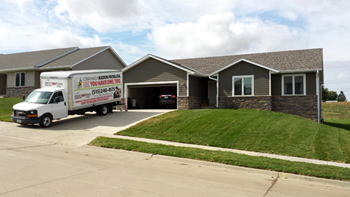Radon Screening Levels in your Des Moines, IA Home
Radon that enters an enclosed space, such as your home, the
 radon can accumulate and the levels can become high. Radon is produced by decaying uranium and radium that are naturally found in soil and rock. It is drawn into homes through cracks in the foundation or slab and through unsealed pipes, sumps, drains, walls and any other opening in your home.
radon can accumulate and the levels can become high. Radon is produced by decaying uranium and radium that are naturally found in soil and rock. It is drawn into homes through cracks in the foundation or slab and through unsealed pipes, sumps, drains, walls and any other opening in your home.
The radon levels in your Des Moines, IA home can be tested by AmeriServe Radon Mitigation of Iowa. Radon is measured in picocuries per liter (pCi/L). The smaller the number the safer you are. However, even small amounts of radon is not safe. The Environmental Protection Agency (EPA) has determined that 4.0 pCi/L is the level that action needs to be taken for indoor air quality. This means that radon levels need to be immediately reduced through mitigation.
Remember though, any level of radon can be dangerous, which is why radon reduction systems are important to have installed. Radon is the second cause of lung cancer after smoking. To better understand radon levels, here are some examples of comparison:
- Radon level of 4.0 pCi/L is equivalent to the radiation from 100 chest x-rays
- Most hospitals only allow people to have four chest x-rays in a year. That is .16 pCi/L per x-ray and .64 pCi/L per year.
- 1 pCi/L is the equivalent to 2.5 cigarettes a day
Radon Testing in your Des Moines, IA Home
Ameriserv Radon Mitigation of Iowa can detect the radon level of your home through short-term testing or long-term testing. Of course the short-term testing is the quickest method. This is done using several different methods. The most common methods short-term testing are:
- charcoal canisters
- electret ion chamber
- continuous monitors
- liquid scintillation detectors
Charcoal canisters and liquid scintillation detectors absorb radon onto the charcoal then the radioactive particles emitted from the charcoal are counted in a laboratory.
The electret ion detectors have a Teflon disc which is statically charged. The ions produced by the decay of radon inside the detector strike the disk, reducing the surface voltage. Then the voltage reduction is measure in a lab and the radon concentration is calculated.
Continuous electronic radon monitors for short-term testing usually provide a more precise measurement of radon than the charcoal canister method.
Short-term testing is usually done when the results are needed quickly such as in a real estate transaction. Radon levels can be affected by the time of day, the varying temperature changes during the day, and the changes from season to season. That is why the long-term testing is more accurate.
Because radon levels can vary from day to day and from season to season, long term testing can be done to get a better ideal of the radon level. This usually takes 90 days or more and gives a more accurate idea of the year round average of radon levels in your home.
Radon testing and mitigation should be done by a licensed, certified specialist. AmeriServ Radon Testing and Mitigation Service has the specialists you need for all of your radon testing and mitigation needs. Don’t hesitate to contact us to get your home tested and keep you and your family safe from radon. We guarantee all of our work and have a 5-year warranty on our radon mitigation systems.
 Our Response to COVID-19
Our Response to COVID-19 
